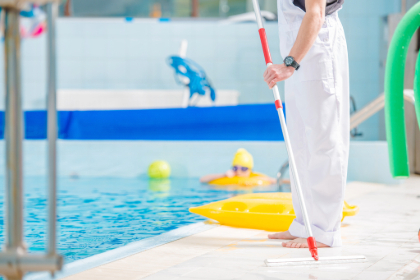BLOG
Don’t let pool problems ruin your summer! Archer Cleaning & Restoration Services in St. Croix Falls, WI, shares must-know pool maintenance tips to keep your pool in shape all season.

A well-maintained pool is more than just a pretty sight; it’s your ticket to safe, refreshing fun all season long. By following a few simple pool maintenance tips, you can prevent algae growth, equipment failure, and even health risks. Regular care also saves you money by avoiding expensive repairs.
Ready to make pool maintenance a breeze? Let’s jump in!
Are you dealing with water, fire, smoke, or mold damage? Trust the local experts at Archer Cleaning & Restoration Services in St. Croix Falls to restore your home with care. Call 888-436-3499 today for fast, reliable help!
Weekly Cleaning Routine
Skimming the Surface
Start by skimming leaves, bugs, and debris off the water’s surface. If possible, do this daily. It keeps your pool looking fresh and prevents organic matter from sinking and causing bigger problems.
Brushing Walls and Floor
Algae and dirt love to cling to your pool’s walls and floor. Scrub every surface with a brush once a week to prevent buildup and keep your pool’s finish in great shape.
Vacuuming the Pool
Vacuuming helps remove fine particles that brushing can miss. You can use a manual vacuum for more control or invest in an automatic pool cleaner for convenience.
Emptying Skimmer and Pump Baskets
Don’t forget to check and empty the skimmer and pump baskets weekly. Clogged baskets reduce water circulation and strain your filtration system.
Chemical Care
Understanding Pool pH
The pH level of your pool should stay between 7.2 and 7.6. This range keeps the water comfortable for swimmers and helps other chemicals work effectively.
Chlorine Levels
Chlorine kills bacteria and keeps water sanitized. For safe swimming, maintain a chlorine level between 1.0 and 3.0 ppm (parts per million).
Alkalinity and Calcium Hardness
Total alkalinity (80–120 ppm) helps stabilize pH levels. Calcium hardness (200–400 ppm) prevents damage to your pool’s surfaces and equipment.
Weekly Testing
Use pool test strips or a liquid test kit once a week. These tools help you monitor pH, chlorine, alkalinity, and hardness with ease.
Adjusting Chemicals Safely
Always add chemicals to water—never the other way around. Wear gloves, follow instructions, and wait the recommended time before swimming.
Have a fire, water, or mold problem? Call the trusted team at Archer Cleaning & Restoration Services in St. Croix Falls. We act fast to protect your home and peace of mind. Call us now at 888-436-3499; we’re ready when you are.
Shock Treatments
What Is Pool Shocking?
Shocking your pool means adding a high dose of chlorine to destroy bacteria, organic matter, and combined chlorine that causes cloudy water and odors.
When to Shock Your Pool
Shock after heavy use, rainstorms, or if you spot algae. Also, do it once every 1–2 weeks as part of regular maintenance.
How to Shock Safely
Read the chlorine label for dosage instructions. Shock in the evening, so sunlight doesn’t reduce effectiveness. Keep swimmers out of the water until chlorine levels return to normal.
Filtration Systems
Types of Filters
Your pool likely uses a sand, cartridge, or DE (diatomaceous earth) filter. Each has pros and cons, but all require regular cleaning.
Filter Maintenance Tips
Backwash sand and DE filters when the pressure gauge rises 8–10 psi above normal. Clean or replace cartridge filters every few weeks or as needed.
Proper Run Time
Run your pump for 8–12 hours daily, especially during peak season. This helps circulate water, distribute chemicals, and trap debris effectively.
Inspecting and Servicing Pool Equipment
Pump and Motor Checkups
Listen for unusual noises and check for leaks. A well-running pump should be quiet and steady.
Heater Maintenance
If you use a heater, have it professionally inspected before and after each season. Keep it clear of leaves and debris.
Pool Cover Maintenance
Keep your cover clean and dry when not in use. Store it properly to prevent mold and damage.
Leaks and Wear
Monitor for unexpected drops in water levels or strange equipment sounds. These may signal leaks or worn parts that need repair.
Safety Tips for a Well-Maintained Pool
Check Ladders, Rails, and Lighting
Tighten loose hardware and replace broken or rusted pieces. Well-maintained accessories help prevent injuries.
Maintain Proper Fencing and Gates
Ensure that gates are self-latching and fences meet local safety codes to keep children and pets safe.
Chemical Storage Safety
Store pool chemicals in a cool, dry, and locked location. Keep them out of reach of kids and pets.
Slip Prevention
Rinse and clean your pool deck regularly. Consider non-slip coatings or mats for extra safety.
Winter Pool Care
Why Winterize Your Pool?
Freezing water can crack pipes, damage filters, and ruin pool surfaces. Winterizing protects your pool during the off-season.
Steps to Winterize
Balance the water’s chemistry. Lower the water level below the skimmer. Drain water from pipes, filters, and pumps. Cover the pool securely.
Ongoing Winter Monitoring
Check the cover regularly for damage. Remove leaves, debris, and snow buildup to avoid strain on the cover and pool frame.
We hope our pool maintenance tips helped! Trust the pros at Archer Cleaning & Restoration Services for the best cleaning and restoration services in St. Croix Falls. Call 888-436-3499 now to schedule service!
Archer Restoration
is a Proud Sponsor of the
Club 905 Polk County Scholarship Fund
Supporting Community Law Enforcement
and Emergency Service Providers
Location








